Dell XPS 15 L521X: A Detailed First Look
by Jarred Walton on July 25, 2012 1:10 AM ESTDell XPS 15 Gaming Performance (with ThrottleStop)
This is where things get a bit messy and confusing. The CPU throttling on BIOS version A01 through A04 is a severe enough problem that out-of-box gaming performance on the XPS 15 is substantially lower than expected. In most games that we tested, CPU throttling kicks in after anywhere from 30 to 90 seconds, at which point the CPU sits at 1.2GHz until you exit the game. This makes benchmark results highly variable, with the first run always being the fastest, and frankly it’s unacceptable. How this slipped through the cracks on a shipping laptop is something of a mystery, as it took all of five minutes with DiRT 3 and Batman: Arkham City for me to determine something was wrong with performance, and to then track down the root cause. OEMs take note: both games have built-in benchmarks and your performance labs should be using these and other high-profile games to check performance before you start shipping product. End of discussion.
Now, with that out of the way, we wanted to see what the XPS 15 could do with a bit of fine tuning on CPU clocks. Under the default settings on the A04 BIOS, CPU temperatures topped out at 80C, which is lower than we’ve seen on quite a few laptops. Furthermore, CPU clocks were almost always 2.8GHz (maximum Turbo Boost for four threads or more on the i7-3612QM) before throttling down to 1.2GHz, which seems rather myopic. The whole point of Intel’s Turbo Boost is to let the CPU run at the maximum sustainable clock speed without overheating, and right now that’s not happening.
A bit of tinkering with ThrottleStop 5.0 Beta 3 yielded CPU temperatures in the 80-90C range with a 23X multiplier, with some games capable of running at 2.5 or even 2.6GHz without overheating. Again, this isn’t something an end user should be required to use in our opinion, but thankfully it does allow substantially improved performance and it’s easy enough to enable/disable as needed. Depending on the game in question, we saw performance improve by anywhere from 10% to over 100% by using a 23X multiplier with the CPU PROC HOT signal disabled—Batman and DiRT 3 showed the greatest improvements. Note also that the difference at higher quality settings isn’t as large, as the GPU becomes more of a bottleneck. We have 1080p “Enthusiast” results for the XPS 15 as well as our 768p “Value” and 900p “Mainstream” scores, but in most games 1080p Enthusiast wasn’t playable so we won’t report those scores for now. Let’s start with our Value and Mainstream results, and then we’ll list “recommended” settings and frame rates for the XPS 15 running at 1080p.
Value Gaming Performance
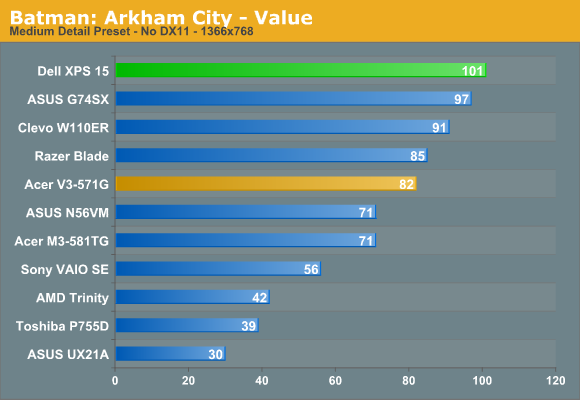

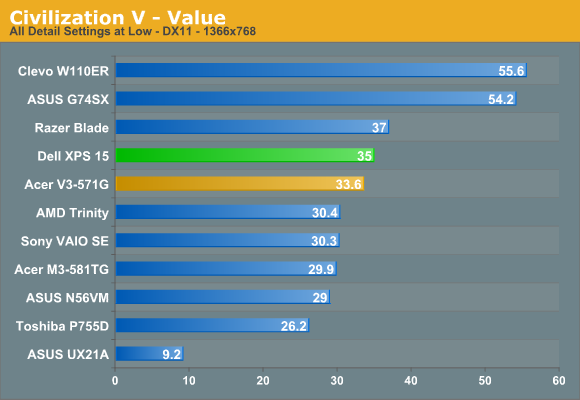

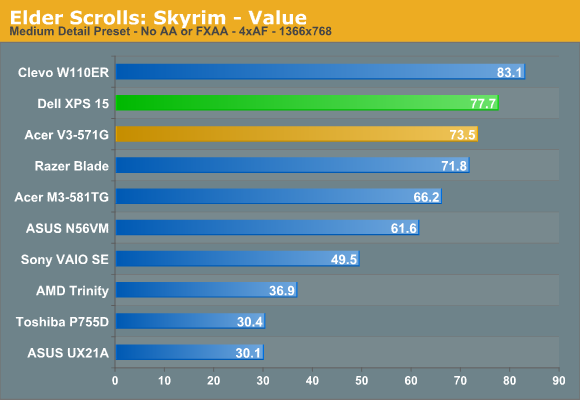
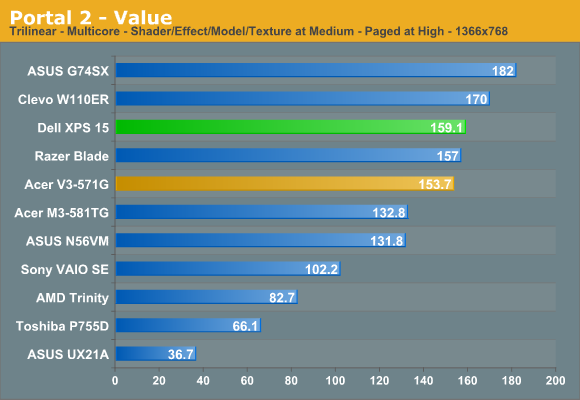
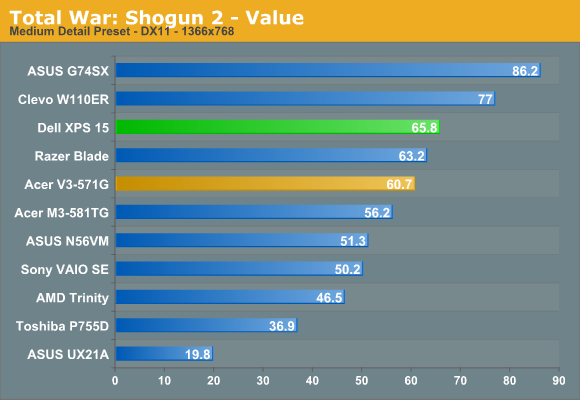
Our Value settings don’t pose any problem for the XPS 15, with all games easily besting 30FPS and most surpassing the 60FPS mark. The XPS 15 basically sweeps the table against the Acer V3, showing the value of using GDDR5 memory instead of DDR3 memory on the GPU. Also worth note is that Civilization V performance continues to be a bit quirky with certain driver versions; the original 296.01 drivers couldn’t even break 30FPS regardless of setting on the XPS 15, while the newer 304.79 beta drivers at least let you get 35FPS. One quick look at the W110ER results however shows that we ought to be able to get performance closer to 50FPS. I ran FRAPS while performing the Civ5 “lategameview” benchmark at one point to see what was going on, and for some reason performance appeared to fluctuate between 50FPS and 35FPS, where normally the frame rate is pretty steady. I’d guess a future NVIDIA driver will address the issue.
Mainstream Gaming Performance
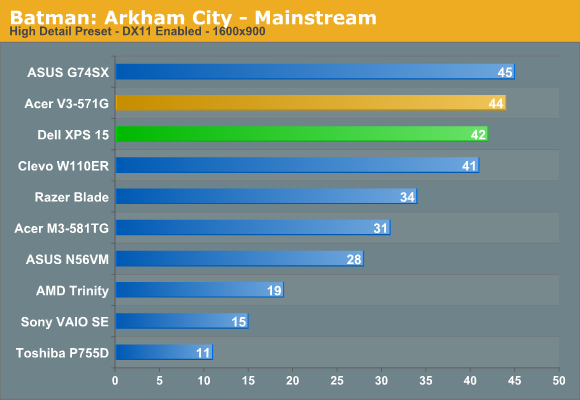
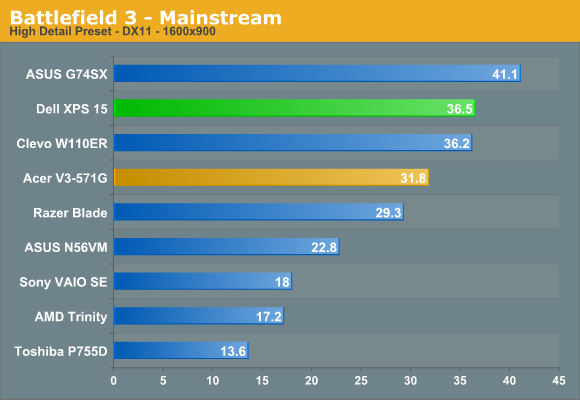
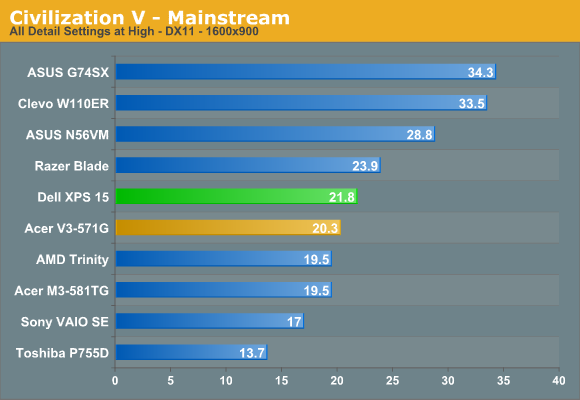
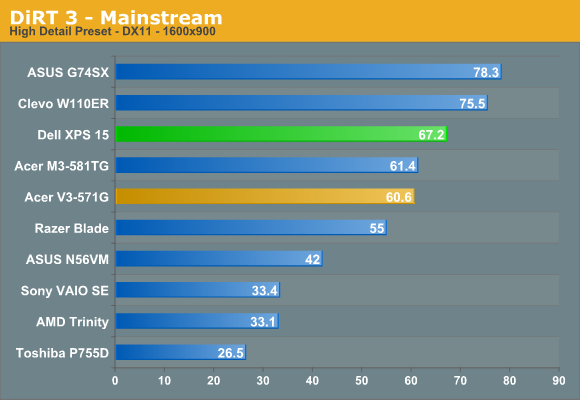
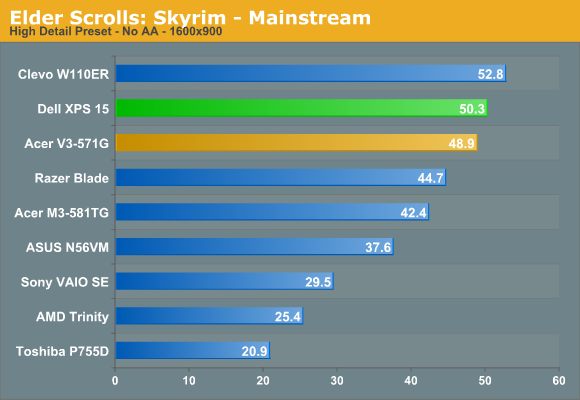
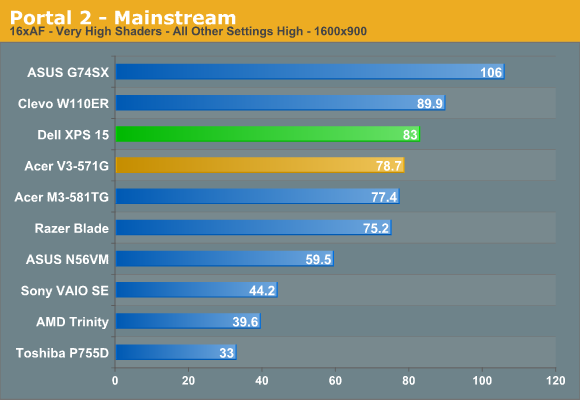

Mainstream performance generally follows the same pattern, only with lower frame rates. The GT 640M with GDDR5 is close to handling all of our test suite at 900p “High” details, with Battlefield 3 and Civilization V being the only two games where we’d recommend dropping to lower detail settings (and again, the drivers are likely a factor in Civ5 performance). It’s also interesting that the Acer V3 manages to eke out a win in Batman, indicating our lowered CPU clocks might be coming into play. Otherwise, the use of GDDR5 is typically able to improve GT 640M performance by an average of 8%, with up to 25% higher performance in at least one game (Batman using our Value settings).
|
Dell XPS 15 Gaming Recommended Settings for 1920x1080 |
|||
| Game | Detail | FPS | Notes |
| Batman: Arkham City |
Very High + 4xAA |
46 |
DX11 and PhysX both tend to be too much for the GT 640M, but you can max everything else out and maintain smooth frame rates. |
| Battlefield 3 |
Medium (“Value”) |
32.6 |
Single-player is okay at these settings, but multi-player will need to drop the resolution or use custom settings with some items on Low. |
| Civilization V | Low (“Value”) | 32.3 |
Civ5 needs a better driver, and we’ve seen higher scores in the past. Until then, setting everything to “Low” is your best bet for 1080p. |
| DiRT 3 | High + 4xAA | 45.8 |
Very fluid at the High defaults with 4xAA. If you try Ultra without AA, you’ll be closer to 30FPS. |
| Portal 2 | Max + 4xAA | 57.8 |
You can pretty much max out the settings in Portal 2 and still maintain fluid frame rates. |
| Skyrim | Ultra + 4xAA | 30.8 |
Skyrim is playable at 30FPS, and so our Enthusiast defaults work well enough. If you want slightly higher performance, you can use FXAA instead of 4xAA and get 35 FPS. |
| Total War: Shogun 2 |
High (“Mainstream”) |
34.8 |
The “High” preset seems to work best, though “Very High” with AA disabled is also viable. |
Most of the games’ settings are straightforward, but a couple warrant further explanation. In Batman, enabling Very High with PhysX is borderline playable, with an average frame rate of 27 FPS; DX11 without 4xAA is a similar 26 FPS, and enabling 4xAA in either mode drops a few FPS whereas FXAA is basically free. Civ5 performance is still a bit chaotic (see below), so take those scores with a grain of salt for now. Finally, our test scene in Skyrim happens to be one of the lowest performing areas we could find, so while we report 30 FPS there are many areas in the game that will run in excess of 60 FPS.
As mentioned earlier, Civilization V and Total War: Shogun 2 ran better with the most recent 304.79 beta drivers, and that’s what we used for the above settings. The remaining games all ran best with the official 296.01 Dell drivers, though at some point we expect to see a new WHQL driver that will provide the best of both worlds (and hopefully further improve Civ5 performance). Not shown in our charts is another popular game, Diablo III; given that the Acer V3 could handle maxed out settings, the same holds for the XPS 15. With GDDR5 memory, the GT 640M ends up being around 10% faster on average compared to DDR3; it can certainly handle gaming at 1080p, but in many games you’ll need to lower the detail settings somewhat to be fully playable.










109 Comments
View All Comments
air_ii - Thursday, July 26, 2012 - link
Given current fan / throttling profiles, wouldn't it be interesting to see gaming performance of a throttled i7/GF vs nominal (or perhaps turboed?) IGP performance? Perhaps the GF is completely pointless under circumstances?TC2 - Thursday, July 26, 2012 - link
The best for the Best :) It's an excellent machine!TheTechSmith - Thursday, July 26, 2012 - link
"And on a related note, I should mention that I’ve seen at least some minor throttling with several other “thin but fast” laptops, so Dell’s not alone here; we’ll be making a concerted effort to check for throttling on all future laptop reviews."Yes! I think this is a great idea. I've believed for years that laptops like the one that you just reviewed have been slapped together without proper thermal design (lack of the required mechanical knowledge, reluctance to put in the required money/time?) in order to sell it on specs, and the end result is terrible, and I don't think there is enough awareness on this issue. I posted a little earlier on my XPS M1330 which is a 4 year old computer with the same issue. If reviews start testing for this specifically and compare laptops quantitatively against other laptops (temperature and average frame-rate of select games over time?), then perhaps companies that are poor in this area will hire the required mechanical engineers and dedicate the proper money and time to do it right.
SovereignGFC - Thursday, July 26, 2012 - link
On page 7, it was noted the laptop shut down under load after ThrottleStop was used to force it to run at a specified speed rather than the BIOS-controlled throttled speed.According to Intel (http://ark.intel.com/products/64901), this CPU is rated for a TJunction (maximum core temperature) of 105C. The CPU only hit 100C during these tests, so that implies to me that CPU temperature, while VERY high, was within spec and should not have triggered a shut-down.
If the GPU hit its limit, that's a different story.
However, as an owner of an XPS1640, well-known for behaving similarly, I have to ask whether the A/C adapter Dell shipped is adequate for such a powerful machine. The A/C adapter was sized based on the machine being throttled, not unlocked the way ThrottleStop will permit it to run. I can offer at least one anecdote (many more can be found on NotebookReview's forums) about A/C adapter vs. thermals. This throttling was present in the Latitude E6X00 series of professional notebooks, one of which is owned by a friend. After showing him how he wasn't getting the performance he paid for, he un-throttled his CPU and ran Prime95 to test its thermals.
The machine shut down in a few minutes and the A/C adapter was too hot to touch for a while afterward.
Many XPS1640 owners reported that calling Dell, mentioning "throttling" and asking for a 130w A/C adapter allowed their machines to run properly under "full load." Even though components would be subjected to high heat (I've seen 103C on my Core 2 Duo, 88C on the GPU) they would also receive enough energy to operate as designed, rather than stressing or even destroying the A/C adapter in the process.
JarredWalton - Thursday, July 26, 2012 - link
I can't test this right now, but the thought that we might be exceeding the power limit did cross my mind. I don't think that's the case, however, as there are various triggers that can cause a system to shut down. I'm guessing Dell defined a maximum temperature of some other component, or that something on the motherboard is overheating. I'll look into power draw when I return home next week.SovereignGFC - Thursday, July 26, 2012 - link
Thanks.What annoys me the most is that we get these half-crippled machines that emphasize form over function. I don't care if it looks like a brick--it's a gaming machine and gaming machines need to dissipate huge amounts of heat.
http://forum.notebookreview.com/dell-xps-studio-xp... - That's a massive discussion about heat/power throttle on the 16XX series.
http://forum.notebookreview.com/dell-xps-studio-xp... - People are already talking about the L521X negatively, "it throttles so badly under a realistic gaming load that I'm returning it."
That said, I don't see any "load" (power) related throttling mentioned.
CeriseCogburn - Sunday, July 29, 2012 - link
Yes, good points.Doesn't matter if this site's is under performing from the lack of adequate ps as that is what end users will be receiving, except in the sense it would be nice to know. It certainly wouldn't surprise me if it was. I doubt they're going to purchase a 130W universal adapter to find out.
Great points, I agree with you, the insane emphasis on looks bothers me as well - it's even worse in discrete video cards, as you won't be staring at them as you game - with a laptop I can excuse quite a bit of it - as you will be looking at it a lot.
SovereignGFC - Monday, July 30, 2012 - link
If enough people complain (like the XPS 16), Dell will give out 130w adapters like candy, even though by themselves they did not solve the problem with the XPS 16. Only completely cutting the BIOS out of the CPU equation and replacing it with ThrottleStop let my laptop run like it was supposed to.If tests on sites like Anand say "This laptop needs MO' POWAH!" then Dell will probably jump at a cheap "fix." I'm not saying we know for sure a larger adapter is required (that's what the tests will be for) but experience suggests power may be a factor.
JarredWalton - Thursday, August 9, 2012 - link
Just to update (and spoil the surprise): I plugged the XPS 15 into a 135W Dell adapter; throttling still occurs just as quickly as before, so it's not a power adapter problem.JNo - Thursday, July 26, 2012 - link
I think the Acer M3 looks might tempting value when looking at the graphs. It's got about 90% of the power for about 50% of the price. Sure it's not all about specs and Acer's build quality and looks are nowhere near that of the Dell but I can't ignore that price differential.So what are you really missing out with the Acer? Two things spring to mind: 1) no SSD - easy; buy your own and clone the HDD and you're still alot cheaper than the Dell with your own preferred brand and size of SSD. 2) The rubbish 1366x786 TN panel on the Acer. This is much trickier I prefer lower resolutions for games anyway but 1650x800 or 1080p would be much better for work. Only question is, can you buy and fit a better panel yourself cheaply if you're willing and able?